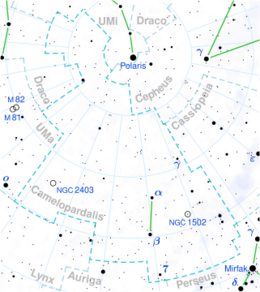Astronomy:HD 45866
| Observation data Epoch J2000.0 Equinox (celestial coordinates) | |
|---|---|
| Constellation | Camelopardalis |
| Right ascension | 06h 40m 28.87701s[1] |
| Declination | +77° 59′ 44.8179″[1] |
| Apparent magnitude (V) | 5.72±0.01[2] |
| Characteristics | |
| Spectral type | K5 III[3] |
| B−V color index | +1.47[4] |
| Astrometry | |
| Radial velocity (Rv) | −16.6±0.2[5] km/s |
| Proper motion (μ) | RA: +13.997[1] mas/yr Dec.: −5.701[1] mas/yr |
| Parallax (π) | 4.4952 ± 0.0455[1] mas |
| Distance | 726 ± 7 ly (222 ± 2 pc) |
| Absolute magnitude (MV) | −0.89[6] |
| Details | |
| Mass | 2.34±0.69[7] M☉ |
| Radius | 49.6±2.6[8] R☉ |
| Luminosity | 468±8[1] L☉ |
| Surface gravity (log g) | 1.62±0.11[7] cgs |
| Temperature | 4,207±140[9] K |
| Metallicity [Fe/H] | −0.11±0.01[10] dex |
| Age | 1.15+0.51−0.35[7] Gyr |
| Other designations | |
| Database references | |
| SIMBAD | data |
HD 45866, also known as HR 2363 is a solitary star[12] located in the northern circumpolar constellation Camelopardalis. It is faintly visible to the naked eye as an orange-hued star with an apparent magnitude of 5.72.[2] Gaia DR3 parallax measurements place it 726 light years away and it is currently approaching the Solar System with a heliocentric radial velocity of −16.6 km/s.[5] At its current distance, HD 45866's brightness is diminished by 0.26 magnitudes due to interstellar dust.[13] It has an absolute magnitude of −0.89[6]
This is an evolved red giant with a stellar classification of K5 III.[3] It has 2.34 times the mass of the Sun[7] but it has expanded to nearly 50 times the radius of the Sun[8] at an age of 1.15 billion years.[7] It radiates 468 times the luminosity of the Sun[1] from its photosphere at an effective temperature of 4,207 K.[9] It has an iron abundance 78% of the Sun's,[10] making it slightly metal deficient.
References
- ↑ 1.0 1.1 1.2 1.3 1.4 1.5 Vallenari, A. et al. (2022). "Gaia Data Release 3. Summary of the content and survey properties". Astronomy & Astrophysics. doi:10.1051/0004-6361/202243940 Gaia DR3 record for this source at VizieR.
- ↑ 2.0 2.1 Høg, E.; Fabricius, C.; Makarov, V. V.; Urban, S.; Corbin, T.; Wycoff, G.; Bastian, U.; Schwekendiek, P. et al. (March 2000). "The Tycho-2 catalogue of the 2.5 million brightest stars". Astronomy and Astrophysics 355: L27–L30. ISSN 0004-6361. Bibcode: 2000A&A...355L..27H.
- ↑ 3.0 3.1 Adams, Walter S.; Joy, Alfred H.; Humason, Milton L.; Brayton, Ada Margaret (April 1935). "The Spectroscopic Absolute Magnitudes and Parallaxes of 4179 Stars". The Astrophysical Journal 81: 187. doi:10.1086/143628. ISSN 0004-637X. Bibcode: 1935ApJ....81..187A.
- ↑ Haggkvist, L.; Oja, T. (1970). "Results of BV photometry 1969-70 (Uppsala refractor)". Private Communication. Bibcode: 1970Priv.........0H.
- ↑ 5.0 5.1 Famaey, B.; Jorissen, A.; Luri, X.; Mayor, M.; Udry, S.; Dejonghe, H.; Turon, C. (January 2005). "Local kinematics of K and M giants from CORAVEL/Hipparcos/Tycho-2 data. Revisiting the concept of superclusters". Astronomy and Astrophysics 430: 165. doi:10.1051/0004-6361:20041272. ISSN 0004-6361. Bibcode: 2005A&A...430..165F.
- ↑ 6.0 6.1 Anderson, E.; Francis, Ch. (May 2012). "XHIP: An extended hipparcos compilation". Astronomy Letters 38 (5): 331–346. doi:10.1134/S1063773712050015. ISSN 1063-7737. Bibcode: 2012AstL...38..331A.
- ↑ 7.0 7.1 7.2 7.3 7.4 Feuillet, Diane K.; Bovy, Jo; Holtzman, Jon; Girardi, Léo; MacDonald, Nick; Majewski, Steven R.; Nidever, David L. (20 January 2016). "Determining Ages of APOGEE Giants with Known Distances". The Astrophysical Journal 817 (1): 40. doi:10.3847/0004-637X/817/1/40. Bibcode: 2016ApJ...817...40F.
- ↑ 8.0 8.1 Kervella, P.; Thévenin, F.; Di Folco, E.; Ségransan, D. (October 2004). "The angular sizes of dwarf stars and subgiants". Astronomy & Astrophysics 426 (1): 297–307. doi:10.1051/0004-6361:20035930. ISSN 0004-6361. Bibcode: 2004A&A...426..297K.
- ↑ 9.0 9.1 Bai, Yu; Liu, JiFeng; Bai, ZhongRui; Wang, Song; Fan, DongWei (2 August 2019). "Machine-learning Regression of Stellar Effective Temperatures in the Second Gaia Data Release". The Astronomical Journal 158 (2): 93. doi:10.3847/1538-3881/ab3048. Bibcode: 2019AJ....158...93B.
- ↑ 10.0 10.1 Sprague, Dani et al. (8 March 2022). "APOGEE Net: An Expanded Spectral Model of Both Low-mass and High-mass Stars". The Astronomical Journal 163 (4): 152. doi:10.3847/1538-3881/ac4de7. ISSN 0004-6256. Bibcode: 2022AJ....163..152S.
- ↑ "HD 45866". SIMBAD. Centre de données astronomiques de Strasbourg. http://simbad.u-strasbg.fr/simbad/sim-basic?Ident=HD+45866.
- ↑ Eggleton, P. P.; Tokovinin, A. A. (11 September 2008). "A catalogue of multiplicity among bright stellar systems". Monthly Notices of the Royal Astronomical Society 389 (2): 869–879. doi:10.1111/j.1365-2966.2008.13596.x. ISSN 0035-8711. Bibcode: 2008MNRAS.389..869E.
- ↑ Gontcharov, George A.; Mosenkov, Aleksandr V. (28 September 2017). "Verifying reddening and extinction for Gaia DR1 TGAS main sequence stars". Monthly Notices of the Royal Astronomical Society 472 (4): 3805–3820. doi:10.1093/mnras/stx2219. ISSN 0035-8711. Bibcode: 2017MNRAS.472.3805G.
 |


